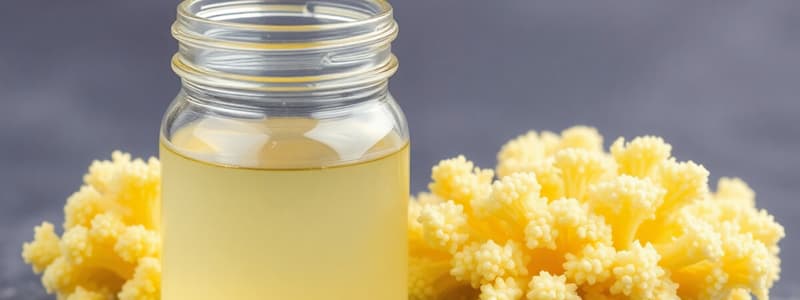Podcast
Questions and Answers
What is the product of the reaction involving $C_6H_{12}O_6$ and $H_2O$ in this sequence?
What is the product of the reaction involving $C_6H_{12}O_6$ and $H_2O$ in this sequence?
- Fumaric acid
- Succinic acid (correct)
- Citric acid
- Malic acid
Which compound is formed when Acetaldehyde reacts with $½ O_2$?
Which compound is formed when Acetaldehyde reacts with $½ O_2$?
- Acetic acid (correct)
- Citric acid
- Fumaric acid
- Malic acid
What type of acid is Succinic acid classified as in this pathway?
What type of acid is Succinic acid classified as in this pathway?
- Dicarboxylic acid (correct)
- Polyunsaturated acid
- Monocarboxylic acid
- Dihydroxy acid
In the transformation from Fumaric acid to Malic acid, what is being added?
In the transformation from Fumaric acid to Malic acid, what is being added?
What distinguishes Citric acid in the context of this biochemical pathway?
What distinguishes Citric acid in the context of this biochemical pathway?
Which organism is primarily of industrial importance for citric acid production?
Which organism is primarily of industrial importance for citric acid production?
Who was the first to describe citric acid as a product of mold fermentation?
Who was the first to describe citric acid as a product of mold fermentation?
What is the pH range for the Currie medium used in citric acid production?
What is the pH range for the Currie medium used in citric acid production?
Which method is used to produce citric acid with molds such as A. wentii and A. niger?
Which method is used to produce citric acid with molds such as A. wentii and A. niger?
What is the effect of treating molasses with cation-exchange or potassium ferrocyanide?
What is the effect of treating molasses with cation-exchange or potassium ferrocyanide?
What is the incubation period for citric acid production using the Doelger and Prescott medium?
What is the incubation period for citric acid production using the Doelger and Prescott medium?
How much sucrose is generally used in the Submerged Culture Method for citric acid production?
How much sucrose is generally used in the Submerged Culture Method for citric acid production?
What percentage of the sugar used may be recovered as citric acid at the completion of the shallow-pan method?
What percentage of the sugar used may be recovered as citric acid at the completion of the shallow-pan method?
What is the result of treating the precipitate with sulfuric acid in the process of citric acid recovery?
What is the result of treating the precipitate with sulfuric acid in the process of citric acid recovery?
According to the Euler theory, which molecule is formed from glucose decomposition?
According to the Euler theory, which molecule is formed from glucose decomposition?
Which theory suggests that hexose breaks down into α and γ–diketoadipic acid?
Which theory suggests that hexose breaks down into α and γ–diketoadipic acid?
In Butkewitsch's proposed mechanism, which process directly leads to the formation of citric acid from glucose?
In Butkewitsch's proposed mechanism, which process directly leads to the formation of citric acid from glucose?
What was the main contribution of Gudlet's theory regarding glucose?
What was the main contribution of Gudlet's theory regarding glucose?
What is the final product when three molecules of acetaldehyde combine, according to the Euler theory?
What is the final product when three molecules of acetaldehyde combine, according to the Euler theory?
Which of the following acids are suggested to combine to form citric acid according to Raistrick and Clark's theory?
Which of the following acids are suggested to combine to form citric acid according to Raistrick and Clark's theory?
Which reaction correctly represents the conversion from glucose to citric acid according to Butkewitsch's theory?
Which reaction correctly represents the conversion from glucose to citric acid according to Butkewitsch's theory?
Flashcards are hidden until you start studying
Study Notes
Citric Acid Fermentation
- Citric acid is a naturally occurring compound found in citrus fruits, pineapples, pears, and other fruits.
- It was first isolated from lemon juice in 1784 by Carl Wilhelm Scheele.
- In 1893, Wehmer discovered that molds could produce citric acid through fermentation.
- Aspergillus niger is the most important microorganism used in industrial citric acid production.
Production Methods
- Surface Culture Method: This traditional method utilizes shallow pans with a nutrient medium containing sucrose, ammonium nitrate, potassium dihydrogen phosphate, and magnesium sulfate.
- Submerged Culture Method: This modern method employs a large-scale fermenter with a nutrient medium containing sucrose, urea, magnesium sulfate, potassium dihydrogen phosphate, potassium chloride, manganese sulfate, and zinc sulfate.
- Cane Molasses: Citric acid can also be produced from cane molasses, but the molasses must be treated to reduce ash content.
Fermentation Process
- The fermentation process for citric acid production typically takes 7-10 days.
- The citric acid is extracted from the fermentation broth by precipitating it as calcium citrate.
- The calcium citrate is then treated with sulfuric acid to liberate the citric acid, resulting in the formation of calcium sulfate as a byproduct.
Citric Acid Formation Theories
- Euler Theory (1909): This theory proposes that glucose is broken down into pyruvic acid, which then decomposes into acetaldehyde and carbon dioxide. Three molecules of acetaldehyde then condense and oxidize to form citric acid.
- Raistrick and Clark Theory (1919): This theory suggests that hexose (glucose) is broken down into α and γ-diketoadipic acid, which then hydrolyzes to acetic acid and oxalacetic acid. These two acids then combine to form citric acid.
- Butkewitsch Theory (1924): This theory proposes that glucose is directly oxidized to citric acid.
- Gudlet Theory (1935): This theory proposes that glucose splits into a 4-carbon molecule (succinic acid) and a 2-carbon compound (acetaldehyde). The succinic acid is converted to malic acid, which then reacts with acetaldehyde and oxygen to form citric acid.
Studying That Suits You
Use AI to generate personalized quizzes and flashcards to suit your learning preferences.




